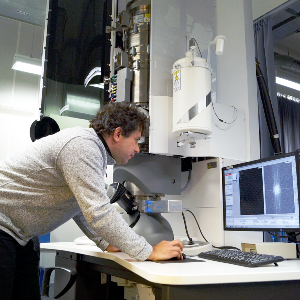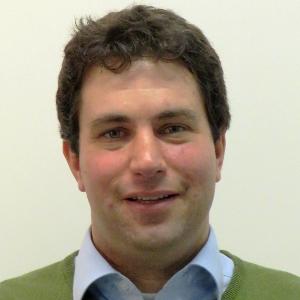ERC Synergy Grant for LMU researcher Knut Müller-Caspary
27 Oct 2023
The funded project will develop approaches for the structural analysis of very small proteins.
27 Oct 2023
The funded project will develop approaches for the structural analysis of very small proteins.

Knut Müller-Caspary am Elektronenmikroskop.
Munich, 26 October 2023 - Through highly competitive Synergy Grant projects, the European Research Council (ERC) supports projects that “enable substantial advances at the frontiers of knowledge” by means of interdisciplinary collaboration. Multidisciplinary teams of two to four researchers receive funding of up to 14 million euros for a period of six years. Professor Knut Müller-Caspary from LMU’s Chair of Transmission Electron Microscopy of Nanostructures is part of one such team, which has now been awarded one of the prestigious grants.
Müller-Caspary studies the structural, chemical, and electrical characterization of nanostructures with subatomic resolution using transmission electron microscopy. A major part of his work is focused on the development of new measurement methods for electron microscopy.
Electron microscopy has led to major scientific advances in the life sciences, physics, and materials science. Cryogenic electron microscopy (cryo-EM) allows scientists to investigate proteins up to a resolution of 1.0 Å. For many smaller molecules, however, the resolution and contrast afforded by established imaging techniques are still insufficient. Over the past few years, Müller-Caspary has been working on 4-dimensional imaging methods for the scanning transmission electron microscopy (STEM) of solids. The combination here of location and diffraction information permits sufficient contrast for light atoms as well as much higher resolution in the range of a few picometers.

Knut Müller-Caspary is awarded a Synergy Grant from the European Research Council. | © Liesbet Laurens
In their ERC Synergy project 4D-BioSTEM, Professors Müller-Caspary (LMU), Carsten Sachse (Jülich Research Center), and Henning Stahlberg (Swiss Federal Institute of Technology, Lausanne) have formed an interdisciplinary team, which brings together approaches from the life sciences and physics in an international collaboration. “We’re developing comprehensive new concepts for structural imaging using 4D datasets and are testing them to ascertain their benefits for the application of cryo-EM in the biosciences,” explains Müller-Caspary. To investigate frozen biological specimens by means of 4D-STEM imaging, the interdisciplinary team utilizes specialized hardware and simulations and develops microscope operating routines and image reconstruction algorithms for the optimal resolution of images. “Our multidisciplinary approach gives us the capability to analyze the structure of much smaller proteins than has previously been possible,” says Müller-Caspary. “The goal on the one hand is to take structural biology research to a new level.” This could allow doctors in future to investigate brain samples, for example, for signs of neurodegenerative diseases with much greater precision. “On the other hand, we also want to exploit the synergy between cryo-EM and physical chemistry in relation to subjects such as the research of catalysts and novel solar cells – the kinds of activities we’re pursuing in the e-conversion Cluster of Excellence,” adds Müller-Caspary.
Knut Müller-Caspary studied physics and obtained his doctorate at the University of Bremen. Subsequently, he worked as a postdoc at the University of Antwerp in Belgium. He was a group leader at Jülich Research Center and a junior professor in the Institute of Physics at RWTH Aachen University before being appointed professor at the Faculty of Chemistry and Pharmacy at LMU in 2021.